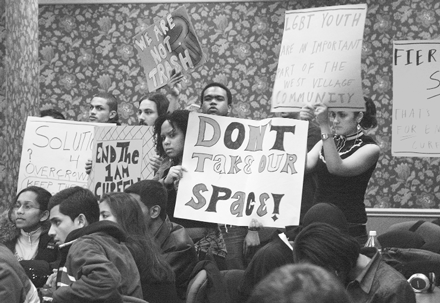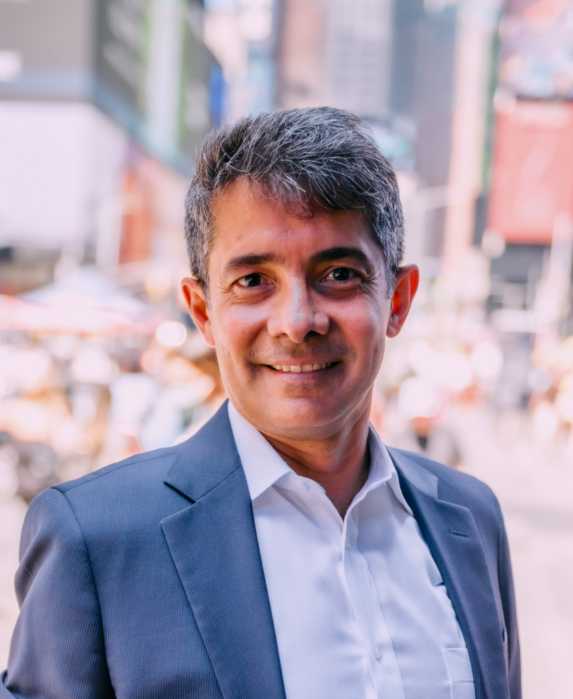Community Board 2 panel floats two ideas on Christopher Street park, but both rejected
Two proposals made by a Community Board 2 committee that are meant to reduce late night crowds in the West Village were effectively rejected by residents of that neighborhood and the queer youth of color who for many years have gathered in the Hudson River Park at the end of Christopher Street.
Arthur Schwartz, chair of the board’s Committee on Waterfront, Parks, Recreation and Open Space, opened the December 6 meeting by offering two proposals that people “could react to.”
One proposal would close the pier at the end of Christopher Street, Pier 45, at 1 a.m., but leave the area between the pier and the West Side highway open. This, presumably, would result in any crowds gathered there slowly dispersing over time.
“The problem was, as we saw it, that they close the park at 1 a.m.,” Schwartz said. “Hundreds of people cross the street and go to Christopher Street and there have been disruptions and noise and other things that happen.”
The second proposal was to close Pier 45 at 1 a.m., but leave the pier across from 13th Street, Pier 54, open later and get food and drink vendors to operate there. This, presumably, would encourage people gathered at Pier 45 to move north to Pier 54 and exit the park over time into a largely non-residential neighborhood.
“The advantage of Pier 54 is that when people disperse, they disperse on to a street that is largely commercial,” Schwartz said.
The proposals would be implemented and evaluated during the spring of 2006. Neither proposal would prevent people from exiting the park at Christopher Street or on any other West Village street. People attending the nearly three-hour meeting did “react to” the proposals, either by rejecting them or ignoring them.
“I think both of your proposals are very, very bad,” said David Poster, president of the Christopher Street Patrol and a longtime West Village resident. Poster is among a group of residents who want the park to close at 11 p.m. and the only exits to be at Houston Street and 14th Street.
“We want the pier closed at 11, period, exclamation point,” Poster said.
The meeting was packed with roughly 100 young people organized by the Fabulous Independent Educated Radicals for Community Empowerment, or FIERCE!, a community group. Some residents went to some lengths to distinguish between the youth in the meeting and those on the streets.
“You do not represent the profile of the people we are talking about,” said Elaine Goldman, co-chair of the Christopher Street Block and Merchant’s Association, of the youth in the room. That comment drew hoots from the crowd because many of those young people do hang out on the piers and they would be affected by any policy change concerning the piers.
Goldman described the late night crowds as an “army of occupation” that included “prostitutes, their enforcers, and potential clients.”
Residents, some of whom were gay, said they were concerned about safety, their own and for the youth on the pier, as well as the noise made by the late night crowds though, in contrast to a November 7 committee meeting, noise, not crime, was the primary complaint voiced by residents.
Police department statistics show that the Sixth Precinct, which patrols the West Village, is one of the safest in the city. That is part of the attraction for young people who may live in neighborhoods where being openly queer is dangerous. A number of speakers said that many of those youth are also homeless with no place to go.
“What I see every day are young people who have been rejected and brutalized,” said Carl Siciliano, the founder and executive director of the Ali Forney Center, a shelter for queer youth. “The West Village has always been seen as a place of tolerance and acceptance.”
One young woman, who wept as she spoke, said that safety was what brings her to the West Village.
“We just need a safe space, but I think it’s wrong for us not to be able to walk up a street,” she said.
Rickke Mananzala, the FIERCE! campaign coordinator, did not comment on either proposal when he spoke at the meeting. Instead he invited the residents to expand the discussion, include more people, and take it outside the setting of the community board meetings.
“These are the youth that are on the pier late at night,” he said. “We don’t want to be at odds with you… We really want to talk with each other in a multi-stakeholder way.”
Any proposal must first be approved by the committee then voted on by the entire community board. The proposal would then be sent to the board of the Hudson River Park Trust, which administers the park that runs along Manhattan’s West Side from 57th Street to Battery Park. Any plan would be implemented only after the trust board approves it.
Following the meeting, Schwartz said that the committee and community board votes could come in January or February. The final plan would likely resemble the two proposals.
“The status quo doesn’t work,” Schwartz said. “Closing it earlier doesn’t work.”
Schwartz said he was “absolutely against” any plan that included closing off West Village streets to people leaving the park.
“My first thought was Stonewall Two,” he said referring to the 1969 riots outside a gay bar on Christopher Street that are seen as launching the modern gay rights movement. He also noted the small number of residents who attended the meeting.
“For a problem that is such a big problem there wasn’t a big turnout,” Schwartz said.
gaycitynews.com
































